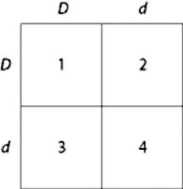Course
General Biology
Study Pack
Set 14 Mendelian Genetics
Question 1
(Multiple Choice)
Free
Which of the following describes why Mendel continued some of his experiments into the F2 or F3 generation?
A) Collecting data from more generations allowed him to obtain a larger number of offspring.
B) Following multiple generations allowed him to determine whether a recessive trait would reappear.
C) Determining whether a dominant trait would reappear required multiple dihybrid crosses.
D) Data from the F1 generation did not allow him to distinguish which alleles were segregating
Answer
Question 2
(Multiple Choice)
Free
Use the figure and the following description to answer the question.
In a particular plant, leaf color is controlled by gene locus D. Plants with at least one allele D have dark green leaves, and plants with the homozygous recessive dd genotype have light green leaves. A true-breeding, dark-leaved plant is crossed with a light-leaved one, and the F1 offspring is allowed to self-pollinate. The predicted outcome of the F1 cross is diagrammed in the Punnett square shown in the figure, where 1, 2, 3, and 4 represent the genotypes corresponding to each box within the square.
Which of the boxes marked 1-4 correspond to plants with dark leaves?
In a particular plant, leaf color is controlled by gene locus D. Plants with at least one allele D have dark green leaves, and plants with the homozygous recessive dd genotype have light green leaves. A true-breeding, dark-leaved plant is crossed with a light-leaved one, and the F1 offspring is allowed to self-pollinate. The predicted outcome of the F1 cross is diagrammed in the Punnett square shown in the figure, where 1, 2, 3, and 4 represent the genotypes corresponding to each box within the square.

Which of the boxes marked 1-4 correspond to plants with dark leaves?
A) 1 only
B) 4 only
C) 1, 2, and 3
D) 2, 3 and 4
Answer
Question 3
(Multiple Choice)
Free
A diploid animal is dihybrid at the Head shape (H) and Tail length (T) loci. Which of the following gamete genotypes can it produce?
A) Hh
B) HhTt
C) HHTT
D) Ht
Answer